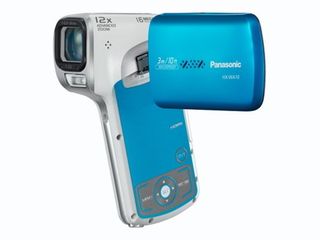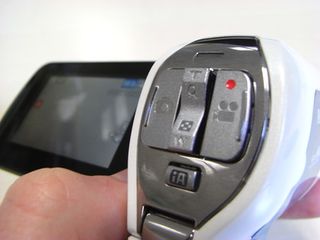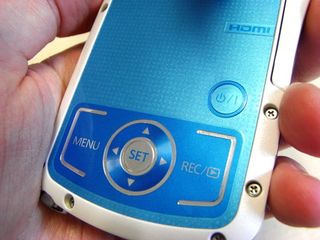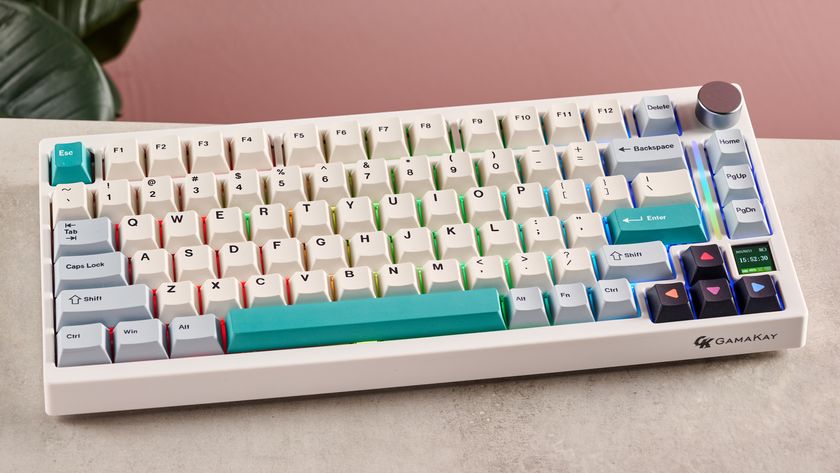TechRadar Verdict
Pros
- +
Great 1080p images
- +
Excellent iA imaging system
- +
Solid waterproofing
- +
Slow-motion recording
Cons
- -
Some wobbling in stabilisation
- -
Wide shots can be a bit soft
Why you can trust TechRadar
The snappily titled HX-WA10 is one of Panasonic's first forays into pistol-style camcorders. These were once Sanyo's bread and butter as part of its Xacti line, but the company was bought by Panasonic several years ago, resulting in the HX-WA10 and its brothers, the HX-DC10 and HX-DC1.
The WA10 is the top of the range, offering a 16-megapixel backside-illuminated sensor capable of recording 1080p footage, all in a waterproof exterior. The DC10 is identical save for its lack of waterproofing, while the DC1 has a 14MP non-backside-illuminated sensor.
Backside-illuminated sensors are hot stuff at the moment thanks to their inclusion in the iPhone 4 and Sony Ericsson Xperia Arc. The reason the technology is so popular is that it should provide improved recording in low-light situations - especially indoors.The WA10 offers a tempting selection of recording formats: 1080/60i, 1080/30p, 720/60p, 720/30p, 540/30p and 480/30p.
Movies are recording as H.264 MP4 files, with audio in two-channel AAC. This is all complemented by electronic image stabilisation (EIS) and a slightly complicated zoom.
The actual optical zoom is 5x, but Panasonic's Advanced Zoom can take this to 12x with no drop in image quality (though only at 30p). We have to say that we didn't even realise it wasn't straight-up optical zoom the whole way at first, so it's obviously doing its job. There's also a further digital zoom, but that comes with the expected loss of detail.

You can monitor and play your recordings back on the 2.6-inch LCD screen (230,400 dots, for those curious). The DC10 and DC1 both have three-inch screen, with the same resolution. The screen isn't quite capable of rotating through 360 degrees, but it's close enough for most use.
The screen darkens quickly when viewed from a high angle, and can be quite reflective, but if you adjust it so that you're viewing straight on, it's smooth detailed and bright.
One of the big features Panasonic has brought to the party is its intelligent auto (iA) processing system, along with live facial recognition technology, which should mean you won't need to go tinkering with any settings to get an ideal picture.
In a normal, well-lit scene, iA will assess all of the best options for you, and tweak as you go. Throw a person into the mix and you'll see boxes over their faces on the screen, and the WA10 will adjust the scene to keep them in the best exposure and focus it can. Go to somewhere dark, and the iA symbol switches to a candle, and it'll start optimising for low-light conditions.
Setting certain picture modes turns iA off by default, and it doesn't come back on automatically, annoyingly. It only requires one button press, though, which is placed conveniently under your thumb.

Just above the iA buttons are the main controls. Here you have your all-important record button, as well as a button for instantly taking a still picture, and a zoom rocker. Because of their waterproof nature, they all feel a little soft when you press them. This actually works in the zoom rocker's favour, though it's not ideal for the others.
However, that's just nit-picking - the buttons are still easy to press, and you'll know if you've pressed them of not because the light will come on.

We're less forgiving of the menu controls on the side of the WA10, though. They're responsive enough, but the arrow keys can be quite fiddly for those with larger digits - you'll be much better off if you've got longer nails.
The thing is, that's not their biggest problem. They inevitably face at a right-angle from the screen, so you can can either look where your fingers are, or look at the options on screen. This will mean a lot of accidental wrong selections. There's nothing can be done and it's not a catastrophic flaw, but it's an irritant owners will have to get used to.
From these menu keys, you can access the WA10's many options. Many of the features we've already mentioned can be turned off or tweaked, and there are scene and colour modes to be tested. You can even opt for manual focus, but since this is adjusted with the menu arrow keys, we don't think you'll make much use of it.
The WA10 takes SD/SDHC/SDXC cards and offers video-out over mini-HDMI (cable not included) or with an AV cable (included). You can get your videos off the device using the USB port.
You can pick the WA10 up for around £250 at the time of writing.
Current page: Panasonic HX-WA10 review: Overview and Features
Next Page Panasonic HX-WA10 review: Performance


